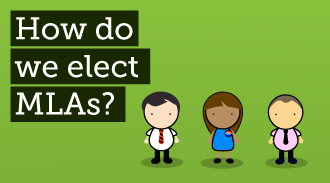Elections
There are 90 MLAs (Members of the Legislative Assembly), representing 18 constituencies. The Northern Ireland (Miscellaneous Provisions) Act 2014 increased the term of an Assembly from 4 to 5 years. Therefore, when an election took place on 5 May 2016, the next election was expected in May 2021. However, things do not always go to plan. Following a breakdown in the relationship between the two main parties in government, the DUP and Sinn Féin, there was a 'snap' election on 2 March 2017. The last election was on 5 May 2022. The results were as follows:
| Party | Seats |
|---|---|
| Sinn Féin (SF) | 27 seats (no change) |
| Democratic Unionist Party | 25 seats (-3) |
| Alliance Party | 17 seats (+8) |
| Ulster Unionist Party (UUP) | 9 seats (-1) |
| Social Democratic and Labour Party (SDLP) | 8 seats (-4) |
| Traditional Unionist Voice (TUV) | 1 seat (no change) |
| People Before Profit (PBP) | 1 seat (no change) |
| Independent | 2 seats |
The Assembly is elected using a system of Proportional Representation (PR) known as Single Transferable Vote (STV).
What is Proportional Representation?
The term describes electoral systems in which candidates win seats in a parliament more or less in proportion to the votes cast.
Supporters of this type of system argue that it reflects voters' choices more accurately than other systems. A voter can usually indicate an order of preference for candidates and more than one candidate is elected to represent a constituency, giving voters a choice of representatives to engage with. This differs from the First Past the Post system used for electing Members of Parliament (MPs) to Westminster. Voters using FPTP choose only one candidate. The candidate with the most votes wins the single seat.
What is STV?
In an election using STV, constituencies elect a set number of candidates. In Northern Ireland this set number is 5 per constituency (originally six). A party can put forward as many candidates as it likes per constituency.
Voters mark the candidates 1, 2, 3, etc. in order of preference, with '1' for their first choice of candidate, '2' for their second and so on. Voters do not have to state a preference for all candidates – they can choose as many or as few as they like.
STV awards seats in proportion to the number of votes cast, with voters’ lower ranking preferences taken into account.
Supporters of proportional representation argue that STV has advantages over ‘First Past the Post’ (FPTP). Under FPTP, each constituency elects only one MP. The names of one candidate for each political party, plus independents, are on the ballot paper. Voters choose one candidate only and the candidate with the most votes wins the seat. They can win with a simple majority and many do so with less than 50 percent of the constituency’s support. In this system ‘the winner takes all’. Constituents who voted for the winning candidate are happy, but others may feel that they are not represented. However, MPs are required to represent everyone in their constituency.
The STV system increases voter choice because they can vote for more than one candidate. They can choose between candidates within a party, as well as between parties. STV allows more voters to affect the outcome of an election.
STV gives smaller parties a better chance in elections, as they may benefit from transfers from larger parties. PR systems tend to produce multi-party ‘coalition’ governments*. FPTP is more likely to produce single party governments. Supporters of FPTP argue that coalition governments are not as stable or effective as single party governments. This is because coalition governments are often formed by parties with opposing political principles. This leads to difficulties in agreeing decisions. Parties may withdraw from government and cause it to collapse.
We have used STV in Northern Ireland for local and European elections since the introduction of Direct Rule, following the suspension of the Northern Ireland Parliament, in 1972. FPTP had maintained single party government (by the Ulster Unionist Party) from its introduction in 1929 until 1972. STV was introduced to provide better representation for those who supported other parties. In Assembly elections, voters can show support for a number of parties and constituents have a choice of MLAs and parties to approach for assistance.
A PR election system, such as STV, ensures that different sections of the community have their views represented in the devolved institutions. It is important that as many people as possible feel represented and included. Since the 2016 election, parties with enough seats are entitled to opposition rights if they decide to opt out of the Executive Committee. Northern Ireland has a unique model of coalition government. Most coalitions are formed when parties agree to work together.
*Northern Ireland uses the d’Hondt system to determine membership of the Executive. D’Hondt is a mathematical formula used to allocate positions of power proportionally based on the number of seats a party has in the Assembly. This is called a ‘mandatory coalition’. The make-up of the coalition reflects the results of the election, the mandate given to parties by the voters. It is a system designed to guarantee power-sharing between representatives from different sections of the community.
Read more about STV and how it works.
Q. What issues would be important to you when deciding how to vote? Do you think your views are represented well by the MLAs in your constituency?

